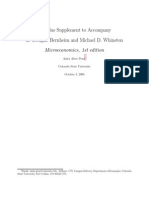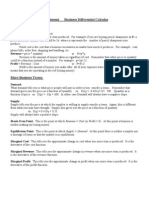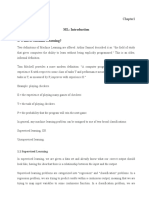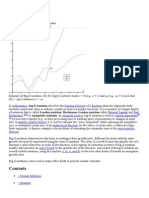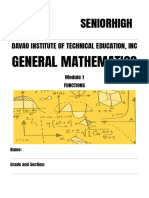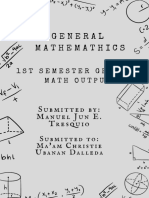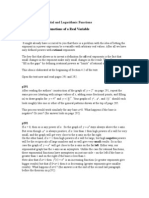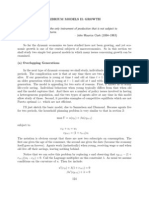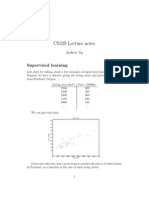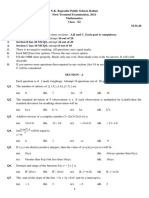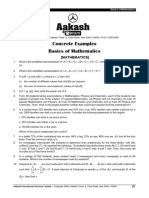Mathematics Review: The Global Economy Class Notes
Mathematics Review: The Global Economy Class Notes
Uploaded by
Ashish MehtaCopyright:
Available Formats
Mathematics Review: The Global Economy Class Notes
Mathematics Review: The Global Economy Class Notes
Uploaded by
Ashish MehtaOriginal Title
Copyright
Available Formats
Share this document
Did you find this document useful?
Is this content inappropriate?
Copyright:
Available Formats
Mathematics Review: The Global Economy Class Notes
Mathematics Review: The Global Economy Class Notes
Uploaded by
Ashish MehtaCopyright:
Available Formats
The Global Economy Class Notes
Mathematics Review
Revised: January 5, 2012 Mathematics is a precise and ecient language for expressing quantitative ideas, including many that come up in business. What follows is an executive summary of everything youll need in this course: functions, exponents and logarithms, derivatives, and spreadsheets, each illustrated with examples.
Functions In economics and business, we often talk about relations between variables: demand depends on price, cost depends on quantity produced, price depends on yield, output depends on input, and so on. We call these relations functions. More formally, a function f assigns a (single) value y to each possible value of a variable x. We write it this way: y = f (x). Perhaps the easiest way to think about a function is to draw it: put x on the horizontal axis and plot the values of y associated with each x on the vertical axis. In a spreadsheet program, you might imagine setting up a table with a grid of values for x. The function would then be a formula that computes a value y for each value of x. Example (demand functions). We may be interested in the sensitivity of demand for our product to its price. If demand is q and price p, an example of a demand function relating the two is q = a + bp, where a and b are parameters (think of them as xed numbers whose values we havent bothered to write down). Sensitivity of demand to price is summarized by b, which wed expect to be negative (demand falls as price rises). Example (bond yields). The price p and yield y for a one-year zero-coupon bond might be related by p = 100/(1 + y), where 100 is the face value of the bond. Note the characteristic inverse relation: high yield, low price. Example (production functions). In this class well relate output Y to inputs of capital K and labor L. (In macroeconomics, capital refers to plant and equipment.) Itll look
Math Review
a little strange the rst time you see it, but a convenient example of such a function is Y = K L1 , where is a number between zero and one (typically we set = 1/3). This is a modest extension of our denition of a function Y depends on two variables, not one but the idea is the same. Exponents and logarithms Exponents and logarithms are useful in lots of situations: elasticities, compound interest, growth rates, and so on. Heres a quick summary. Exponents. Exponents are an extension of multiplication. If we multiply x by itself, we could write either x x or x2 , where 2 is an exponent (or power). In general, we can write xa to mean (roughly) x multiplied by itself a times, although this language may seem a little strange if a isnt a positive whole number like 2 or 3. We can nevertheless compute such quantities for any value of a we like as long as x is positive. (Think about how youd do this in a spreadsheet.) The most useful properties of exponents are xa xb = xa+b xa y a = (xy)a (xa )b = xab . You can work these out for yourself using our multiplication analogy. Logarithms. By logarithm we mean the function LN in Microsoft Excel, OpenOce Calc, or Google spreadsheets, sometimes called the natural logarithm. This will seem strange, perhaps worse, but the natural logarithm of a number x comes from the power of a number e, a mathematical constant that is approximately 2.718. If x = ey , then y is the logarithm of x, expressed y = log x. (There are other logarithms based on powers of other numbers, but well stick with e.) Suppose, instead, you know that y is the logarithm of x. How do you nd x? From the denition, apparently x = ey . In Excel, this is written exp(y). As a check, you might verify that log 6 = 1.792 and exp(1.792) = 6.00. The most useful properties of logarithms are log(xy) log(x/y) log(xa ) log(ex ) elog x = = = = = log x + log y log x log y a log x x x.
Math Review
In short, logarithms convert multiplication into addition, division into subtraction, and exponentiation into multiplication. In each case, an operation is converted into a simpler one: addition, for example, is simpler than multiplication. Example (demand functions). A more useful demand function is q = apb , which is linear in logarithms: log q = log a + b log p. This follows from the rst and third properties of logarithms. Here b is the price elasticity. Example (compound interest). Our earlier relation between price and yield was based on a compounding interval of one year, the same as the maturity of the bond. In practice, people use lots of dierent compounding intervals, creating no end of confusion. US treasuries, for example, are based on semi-annual compounding, which implies p = 100/(1 + y/2)2 , where y is the semi-annually compounded yield. If we compound n times a year, the relation is p = 100/(1 + y/n)n . If n = 2 we compound twice a year (semi-annually), if n = 12 we compound twelve times a year (monthly), and so on. For n large, this becomes (trust us) p = 100 ey = 100 exp(y), where y is referred to as the continuously-compounded yield. With continuous compounding, how do we nd the yield if we know the price? The answer: use y = log 100 log p. (This follows from the rst and fourth properties of logarithms.) Example (long bonds). The choice of compounding interval is arbitrary we can choose any interval we like. For a zero-coupon bond with a maturity of m years, three versions of the relation between the price p and yield y are Annual compounding: Semi-annual compounding: Continuous compounding: p = 100/(1 + y)m p = 100/(1 + y/2)2m p = 100 emy = 100 exp(my).
The choice is a matter of convenience and tradition: each denition of the yield contains the same information. Whats nice about continuous compounding is that, once you take logs, you simply multiply the yield times the number of periods, rather than the more complicated compounding we usually get. Example (growth in the US). In the US, real GDP was $10,074.8b in 2002, $10,381.3b in 2003. What was the growth rate? Approach 1 (annual compounding): solve 1 + g = 10381.3/10074.8
Math Review
for the (simple) growth rate g. The answer: g = (10381.3/10074.8) 1 = 0.0304 = 3.04%. Approach 2 (continuous compounding): solve e = 10381.3/10074.8 for . The answer: = log(10381.3/10074.8) = 0.0300 = 3.00%. The answers are very similar, which will be true as long as the growth rates are small. If you plot both over time for the US, youll have a hard time telling the dierence. Well typically use the second approach. Example (growth in Korea). GDP per capita in Korea was $770 in 1950, $14,343 in 2000, measured in 1990 US dollars. What was the average annual growth rate? Approach 1 (annual compounding): nd the number g satisfying 14343 = (1 + g)50 770. How do we nd g? Using logarithms, of course! Note that log(14343/770) = 50 log(1 + g). Since log(14343/770) = 2.925, log(1+g) = 2.925/50 = 0.0585, and 1+g = exp(0.0585) = 1.0602. Thus the growth rate was 6.02% a year, which is extraordinarily high. Approach 2 (continuous compounding): solve 14343 = e50 770. The answer: 50 = log(14343/770) = 2.925, so = 2.925/50 = 0.0585 or 5.85%.
Slopes and derivatives The slope of a function is a measure of how steep it is: the ratio of the change in y to the change in x. For a straight line, we can nd the slope by choosing two points and computing the ratio of the change in y to the change in x. For some functions, though, the slope (meaning the slope of a straight line tangent to the function) is dierent at every point. The derivative of a function f (x) is a second function f (x) that gives us its slope at each point x if the function is continuous (no jumps) and smooth (no kinks). Formally, we say that the derivative is f (x + x) f (x) y = x x for a really small x. (You can imagine doing this on a calculator or computer using a particular small number, and if the number is small enough your answer will
Math Review
be pretty close.) We express the derivative as f (x) or dy/dx and refer to it as the derivative of y with respect to x. The ds are intended to be suggestive of small changes, analogous to but with the understanding that we are talking about very small changes. So the derivative is a function f (x) that gives us the slope of a function f (x) at every possible value of x. What makes this useful is that there are some relatively simple mechanical rules for nding f for common functions f . See Exhibit 1. If these rules are new to you, take them as facts to be memorized and put to work. Example (marginal cost). Suppose total cost c is related to the quantity produced q by c = 100 + 10q + 2q 2 . Marginal cost is the derivative of c with respect to q. How does it vary with q? The derivative of c with respect to q is dc/dq = 10 + 4q, so marginal cost increases with q. Example (bond duration). Fixed income analysts know that prices of bonds with long maturities are more sensitive to changes in their yields than those with short maturities. They quantify sensitivity with duration D, dened as D = d log p . dy
In words, duration is the ratio of the percent decline in price (the change in the log) over the increase in yield for a small increase. Two versions follow from dierent compounding conventions. With annual compounding, the price of an m-year zerocoupon bond is related to the yield by p = 100/(1 + y)m . Therefore log p = log 100 m log(1 + y) and duration is D = m/(1 + y). With continuous compounding, p = 100 exp(my), log p = log 100 my, and D = m. In both cases, its clear that duration is higher for long maturity bonds (those with large m). Example (marginal product of capital). Suppose output Y is related to inputs of capital K and labor L by Y = K L1 for between zero and one. If we increase K holding L xed, what happens to output? We call the changes in output resulting from small increases in K the marginal product of capital. We compute it as the derivative of Y with respect to K holding L constant. Since were holding L constant, we call this a partial derivative and write it Y = K 1 L1 = (L/K)1 . K
Math Review
Despite the change in notation, we nd the derivative in the usual way, treating L like any other constant.
Finding the maximum of a function An important use of derivatives is to nd the maximum (or minimum) of a function. Suppose wed like to know the value of x that leads to the highest value of a function f (x), for values of x between two numbers a and b. We can nd the answer by setting the derivative f (x) equal to zero and solving for x. Why does this work? Because a function is at (has zero slope) at a maximum. (Thats true, anyway, as long as the function has no jumps or kinks in it.) We simply put this insight to work. Fine points (feel free to skip). Does this always work? If we set the derivative equal to zero, do we always get a maximum? The answer, in a word, is no. Here are some of the things that could go wrong: (i) The point could be a minimum, rather than a maximum. (ii) The maximum could be at one of the endpoints, a or b. Theres no way to tell without comparing your answer to f (a) and f (b). (iii) There may be more than one local maximum (picture a wavy line). (iv) The slope might be zero without being either a maximum or a minimum: for example, the function might increase for a while, atten out (with slope of zero), then start increasing again. An example is the function f (x) = x3 at the point x = 0. [You might draw functions for each of these problems to illustrate how they work.] If you want to be extra careful, there are ways to check for each of these problems. One is the co-called second-order condition: a point is a maximum if the second derivative [the derivative of f (x)] is negative. All of these things can happen in principle, but one of our jobs is to make sure they do not happen in this class. And they wont. Example (maximizing prot). Heres an example from Firms & Markets. Suppose a rm faces a demand for its product of q = 10 2p (q and p being quantity and price, respectively). The cost of production is 2 per unit. What is the rms prot function? What level of output produces the greatest prot? Answer. Prot is revenue (pq) minus cost (2q). The trick (and this isnt calculus) is to express it in terms of quantity. Apparently we need to use the demand curve to eliminate price from the expression for revenue: p = (10 q)/2 so pq = [(10 q)/2]q. Prot (expressed as a function of q) is therefore Prot(q) = [(10 q)/2]q 2q = 5q q 2 /2 2q. To nd the quantity associated with maximum prot, we set the derivative equal to zero: dProt = 3 q = 0, dq
Math Review
so q = 3. Whats the price? Look at the demand curve: if q = 3, then p satises 3 = 10 2p and p = 7/2. Example (demand for labor). A rm produces output Y with labor L and a xed amount of capital K, determined by past investment decisions, subject to the production function Y = K L1 . If each unit of output is worth p dollars and each unit of labor costs w dollars, then prot is Prot = pK L1 wL. The optimal choice of L is the value that sets the derivative equal to zero: Prot = p(1 )(K/L) w = 0. L (We use a partial derivative here to remind ourselves that K is being held constant.) The condition implies ]1/ [ p(1 ) . L = K w You can think of this as the demand for labor: given values of K, p, and w, it tells us how much labor the rm would like to hire. As you might expect, at higher wages w, labor demand L is lower.
Spreadsheets Spreadsheets are the software of choice in many environments. If youre not familiar with the basics, heres a short overview. The structure is similar in Microsoft Excel, OpenOce Calc, and Google documents. The rst step is to make sure you have access to one of these programs. If you have one of them on your computer, youre all set. If not, you can download OpenOce at www.openoce.org or open a Google spreadsheet at docs.google.com. Both are free. In each of these programs, data (numbers and words) are stored in tables with the rows labeled with numbers and the columns labeled with letters. Heres an example: A x1 3 8 5 B x2 25 13 21 C
1 2 3 4 5
Math Review
The idea is that we have two (short) columns of data, with variable x1 in column A and variable x2 in column B. Here are some things we might want to do with this data, and how to do it: Basic operations. Suppose you want to compute the natural logarithm of element B2 and store it in C2. Then in C2 you would type: =LN(B2). (Dont type the period, its part of the punctuation of the sentence.) The answer should appear almost immediately. If you want to add the second observation (row 3) of x1 and x2 and put in in C3, then in C3 you type: =A3+B3. Statistics. Suppose you want to compute the sample mean and standard deviation of x1 and place them at the bottom of column A. Then in A5 type: =AVERAGE(A2:A4). That takes the numbers in column A from A2 to A4 and computes the sample mean or average. The standard deviation is similar: in A6 you type =STDEV(A2:A4). Finally, to compute the correlation between x1 and x2, you type (in any cell you like): =CORREL(A2:A4,B2:B4). If youre not sure what these functions refer to, see the links to the Kahn Academy videos at the end.
Review questions If youre not sure you followed all this, give these a try: 1. Growth rates. Per capita income in China was 439 in 1950, 874 in 1975, and 3425 in 2000, measured in 1990 US dollars. What were the annual growth rates in the two subperiods? Answer. The average continuously-compounded growth rates were 2.75% and 5.46%. The simple growth rates (these are harder) are 2.79% and 5.62%, so theres not much dierence between them. 2. Find the derivative of each of these functions: (a) 2x + 27 [2] (b) 2x2 + 3x + 27 [4x + 3] (c) 2x2 + 3x 14 [4x + 3] (d) (x 2)(2x + 7) [4x + 3] (e) log(2x2 + 3x 14) [(4x + 3))/(2x2 + 3x 14)] (f) 3x8 + 13 [24x7 ]
Math Review (g) 3x2/3 [2x1/3 = 2/x1/3 ] (h) 2e5x [10e5x ] Answers in brackets [ ]. 3. Suppose output is related to the amount of capital used by Y = 27K 1/3 .
Compute the marginal product of capital (the derivative of Y with respect to K) and describe how it varies with K. Answer. The marginal product of capital is MPK = 9K 2/3 = 9/K 2/3 is positive and falls as we increase K. We call this diminishing returns: the more capital we add, the less it increases output. 4. Find the value of x that maximizes each of these functions: (a) x2 2x [f (x) = 2x 2 = 0, x = 1] (b) 2 log x x [f (x) = 2/x 1 = 0, x = 2] (c) 5x2 2x + 11 [f (x) = 10x 2 = 0, x = 1/5] 5. You have the following data: 4, 6, 3, 4, 5, 8, 5, 3, 6. What is the mean? (Use a spreadsheet program to do the calculation.) Answer. 4.89.
If youre looking for more If these notes seem mysterious to you, we recommend the Kahn Academy. He has wonderful short videos on similar topics, including logarithms (look for Proof: log a ...), calculus (look for Calculus: Derivatives ...), and statistics (start at the top). For spreadsheets, the Google doc tutorial is quite good.
c 2012 NYU Stern School of Business
Math Review Exhibit 1. Rules for Computing Derivatives
10
Function f (x)
Derivative f (x) Rules for Specic Functions
Comments
a ax + b axb aebx a log x
0 a baxb1 baebx a/x
a a a a a
is a number and b are numbers and b are numbers and b are numbers is a number
Rules for Combinations of Functions g(x) + h(x) ag(x) + bh(x) g(x)h(x) g(x)/h(x) g[h(x)] g (x) + h (x) ag (x) + bh (x) g(x)h (x) + g (x)h(x) [g (x)h(x) g(x)h (x)]/[h(x)]2 g [h(x)]h (x)
a and b are numbers h(x) = 0 chain rule
You might also like
- LP in Math Divide FractionDocument3 pagesLP in Math Divide FractionChristine Joyce Lacsina Lacsamana100% (6)
- Ecu - 07103 Lecture Notes PDFDocument63 pagesEcu - 07103 Lecture Notes PDFKhalid Mahadhy0% (1)
- Mathematics of Management NotesDocument51 pagesMathematics of Management Notesraja kashyapNo ratings yet
- Bernheim Calculus FinalDocument122 pagesBernheim Calculus Finalsrinjoy100% (1)
- Maths Notes: Matter If You Do Not Know Everything!Document40 pagesMaths Notes: Matter If You Do Not Know Everything!Rachel FangNo ratings yet
- Calculus Tricks #1: Eric DoviakDocument18 pagesCalculus Tricks #1: Eric Doviakajaysharma19686191No ratings yet
- Big O PDFDocument11 pagesBig O PDFomonda_niiNo ratings yet
- Mathematical Modelling and FunctionsDocument6 pagesMathematical Modelling and FunctionsDr Srinivasan Nenmeli -K100% (1)
- Chuong23 Phu LucDocument12 pagesChuong23 Phu LucHai NgocNo ratings yet
- Exponential and Logarithmic EquationsDocument10 pagesExponential and Logarithmic EquationsOscar OyakapelNo ratings yet
- Logarithmic and Exponential FunctionsDocument22 pagesLogarithmic and Exponential FunctionsAshley MorganNo ratings yet
- Introduction To CalculusDocument10 pagesIntroduction To CalculusKez MaxNo ratings yet
- 00 Matematica y AlgebraDocument33 pages00 Matematica y AlgebraFede HellemeyerNo ratings yet
- Partial DerivativesDocument5 pagesPartial DerivativeshussainboiNo ratings yet
- 1 Constrained Optimization: 1.1 Structure of The ProblemDocument4 pages1 Constrained Optimization: 1.1 Structure of The ProblemSam SmrdaNo ratings yet
- Preliminaries Basic CalculusDocument17 pagesPreliminaries Basic CalculusAaron KramerNo ratings yet
- Basic Calculus and ApplicationsDocument22 pagesBasic Calculus and Applicationspriyadharshini869728No ratings yet
- Matematika I Statistika Za IMQFDocument208 pagesMatematika I Statistika Za IMQFGo WolowitzNo ratings yet
- Math Review: 1 Notation and DefinitionsDocument24 pagesMath Review: 1 Notation and DefinitionssafowanNo ratings yet
- 1526 BusinesstermsDocument2 pages1526 Businesstermsdenesha2010No ratings yet
- Functions VariablesDocument184 pagesFunctions VariablesMarkWeberNo ratings yet
- Introductory Econometrics: Regression Functional Form, Model Selection, PredictionDocument32 pagesIntroductory Econometrics: Regression Functional Form, Model Selection, Predictionchanlego123No ratings yet
- Impossibility Theorems For Elementary Integration: Brian ConradDocument13 pagesImpossibility Theorems For Elementary Integration: Brian Conradbikis2008No ratings yet
- ML: Introduction 1. What Is Machine Learning?Document38 pagesML: Introduction 1. What Is Machine Learning?rohitNo ratings yet
- Big O NotationDocument19 pagesBig O Notationmenilanjan89nL100% (1)
- MATH 117 Lecture1and2Document6 pagesMATH 117 Lecture1and2a2hasijaNo ratings yet
- Boston University School of Management: BU Note # 222-1Document19 pagesBoston University School of Management: BU Note # 222-1nurfansuri000No ratings yet
- Module 1 - GENERAL MATHEMATICSDocument19 pagesModule 1 - GENERAL MATHEMATICSKristine AlcordoNo ratings yet
- Classification-Introduction, Logistic RegressionDocument26 pagesClassification-Introduction, Logistic Regressiona.c.isc.i.om.i.re.l.esNo ratings yet
- Chapter One 1.1. Theoretical Versus Mathematical Economics Example. ExampleDocument19 pagesChapter One 1.1. Theoretical Versus Mathematical Economics Example. ExampleEnyewNo ratings yet
- FunctionsDocument14 pagesFunctionsl3önimation cumNo ratings yet
- From Navier Stokes To Black Scholes - Numerical Methods in Computational FinanceDocument13 pagesFrom Navier Stokes To Black Scholes - Numerical Methods in Computational FinanceTrader CatNo ratings yet
- Econ7020X FinalReview (Answers)Document10 pagesEcon7020X FinalReview (Answers)Afra JaggerNo ratings yet
- Notes On "Applied Calculus", Flath/Gleason/et - Al.Document128 pagesNotes On "Applied Calculus", Flath/Gleason/et - Al.Andrew DabrowskiNo ratings yet
- Econ300 Problem SetsDocument12 pagesEcon300 Problem SetsMark VazquezNo ratings yet
- Gen-Math PresentationDocument28 pagesGen-Math PresentationManuel TresquioNo ratings yet
- BasicsDocument8 pagesBasicsgrahn.elinNo ratings yet
- 2014 Ensenar A Investigar Una Didactica Nueva de La Investigacion en Ciencias Sociales y HumanasDocument17 pages2014 Ensenar A Investigar Una Didactica Nueva de La Investigacion en Ciencias Sociales y HumanasMica ElaNo ratings yet
- Math For Machine Learning: 1.1 Differential CalculusDocument21 pagesMath For Machine Learning: 1.1 Differential CalculusjoekowalskyNo ratings yet
- Wa0016.Document8 pagesWa0016.sanittarosNo ratings yet
- Mathematical NotesDocument5 pagesMathematical NotesashNo ratings yet
- 4.1 - Exponential Functions of A Real VariableDocument12 pages4.1 - Exponential Functions of A Real VariablealqpNo ratings yet
- Man Eco - Final Part 3 Huhu KainisDocument25 pagesMan Eco - Final Part 3 Huhu KainisYve LuelleNo ratings yet
- 2Document3 pages2Lucky DeltaNo ratings yet
- Elementary CalculusDocument10 pagesElementary CalculusGetachew HussenNo ratings yet
- Knowledge Is The Only Instrument of Production That Is Not Subject To Diminishing ReturnsDocument77 pagesKnowledge Is The Only Instrument of Production That Is Not Subject To Diminishing ReturnsnvjcharyNo ratings yet
- Fernando, Logit Tobit Probit March 2011Document19 pagesFernando, Logit Tobit Probit March 2011Trieu Giang BuiNo ratings yet
- Part 3 Nonlinear Op Tim IzationDocument69 pagesPart 3 Nonlinear Op Tim Izationsunshine4uNo ratings yet
- CK12 TrigonometryDocument629 pagesCK12 TrigonometryBelmira Mota100% (1)
- Lecture 2Document75 pagesLecture 2Nikoli MajorNo ratings yet
- Exponents and LogarithmsDocument3 pagesExponents and LogarithmselizaclassroomNo ratings yet
- Polynomial FactoringDocument5 pagesPolynomial Factoringapi-126876773No ratings yet
- Exponential and Logarithmic FunctionsDocument24 pagesExponential and Logarithmic FunctionsMary Jane PLNo ratings yet
- CS229 Lecture Notes: Supervised LearningDocument30 pagesCS229 Lecture Notes: Supervised LearninganilkramNo ratings yet
- CS229 Lecture Notes: Supervised LearningDocument30 pagesCS229 Lecture Notes: Supervised LearningAlistair GnowNo ratings yet
- 232ICS202 02 ComplexityAnalysisDocument46 pages232ICS202 02 ComplexityAnalysismodyzombie82No ratings yet
- Big-O NotationDocument8 pagesBig-O Notationjc_asidoNo ratings yet
- MATH98Document7 pagesMATH98ChristineNo ratings yet
- Homework Block WebsitesDocument7 pagesHomework Block Websitesafnawvawtfcjsl100% (1)
- Statistics ElectDocument8 pagesStatistics ElectSiddharth DasNo ratings yet
- Manav Rachna International Institute of Reasearch & Studies: Faculty of Engineering and TechnologyDocument3 pagesManav Rachna International Institute of Reasearch & Studies: Faculty of Engineering and TechnologyGamerSPIDEYNo ratings yet
- Math Analysis Semester 1 Final ReviewDocument10 pagesMath Analysis Semester 1 Final ReviewmayanbNo ratings yet
- 2021 Orientation Math FairDocument49 pages2021 Orientation Math FairJessel CarilloNo ratings yet
- Pengolahan Sinyal Digital: Adhi Harmoko SaputroDocument56 pagesPengolahan Sinyal Digital: Adhi Harmoko SaputroKevin AkmalansyahNo ratings yet
- Normed and Banach SpacesDocument9 pagesNormed and Banach SpacesrafatshaabNo ratings yet
- Exam STATDocument3 pagesExam STATcharlene albateraNo ratings yet
- Lect 5 Bezier CurveDocument60 pagesLect 5 Bezier CurveProff Moffat JamesNo ratings yet
- Theory and Its Applications: Evolutionary Algorithms and OptimizationDocument113 pagesTheory and Its Applications: Evolutionary Algorithms and OptimizationMoshira EssamNo ratings yet
- Ec 2204-Signals and SystemsDocument5 pagesEc 2204-Signals and SystemsragvshahNo ratings yet
- Class - 11 - Maths - McqsDocument6 pagesClass - 11 - Maths - McqsAditya ChawlaNo ratings yet
- Formula Sheet For Final - ExamDocument1 pageFormula Sheet For Final - ExamIsabel EirasNo ratings yet
- Samplepaper 1Document2 pagesSamplepaper 1Shubham GuptaNo ratings yet
- COA MidsemDocument376 pagesCOA MidsemSiddhant SinghaniaNo ratings yet
- Setting Up System of Equation Word ProblemsppDocument9 pagesSetting Up System of Equation Word Problemsppapi-327041524No ratings yet
- Mental MathDocument8 pagesMental MathNaw AyeNo ratings yet
- Convolutional Neural Network - Towards Data Science PDFDocument10 pagesConvolutional Neural Network - Towards Data Science PDFNourhan MohamedNo ratings yet
- Lattice MultiplicationDocument16 pagesLattice MultiplicationJoel ObradorNo ratings yet
- Concrete-1 Basic of MathematicsDocument3 pagesConcrete-1 Basic of MathematicsdhulldikshantNo ratings yet
- ELA Lect 1 To 35 Combine MCQ'sDocument111 pagesELA Lect 1 To 35 Combine MCQ'sIzza Shafique Izza ShafiqueNo ratings yet
- Coupled Reaction-Diffusion Waves in A Chemical System Via Fractional Derivatives in Liouville-Caputo SenseDocument9 pagesCoupled Reaction-Diffusion Waves in A Chemical System Via Fractional Derivatives in Liouville-Caputo SenseRakesh KumarNo ratings yet
- Unit 3 Chapter 3 (Limits and Continuity)Document9 pagesUnit 3 Chapter 3 (Limits and Continuity)secretsuperstarNo ratings yet
- Chapter 2 Roots of EquationDocument21 pagesChapter 2 Roots of EquationShyn ClavecillasNo ratings yet
- Fuzzy Logic BasicsDocument10 pagesFuzzy Logic BasicsHaider Ali AbbasiNo ratings yet
- Fractional Analysis of Jeffrey Fluid Over A Vertical Plat - 2022 - Journal of CoDocument14 pagesFractional Analysis of Jeffrey Fluid Over A Vertical Plat - 2022 - Journal of CodeivisNo ratings yet
- PythonDocument22 pagesPythonYashika JaiswalNo ratings yet
- Min Oh 1995 PHD ThesisDocument183 pagesMin Oh 1995 PHD ThesisPriya DasNo ratings yet
- Chapter 7 SPREADSHEET MODELSDocument46 pagesChapter 7 SPREADSHEET MODELSkeithNo ratings yet



